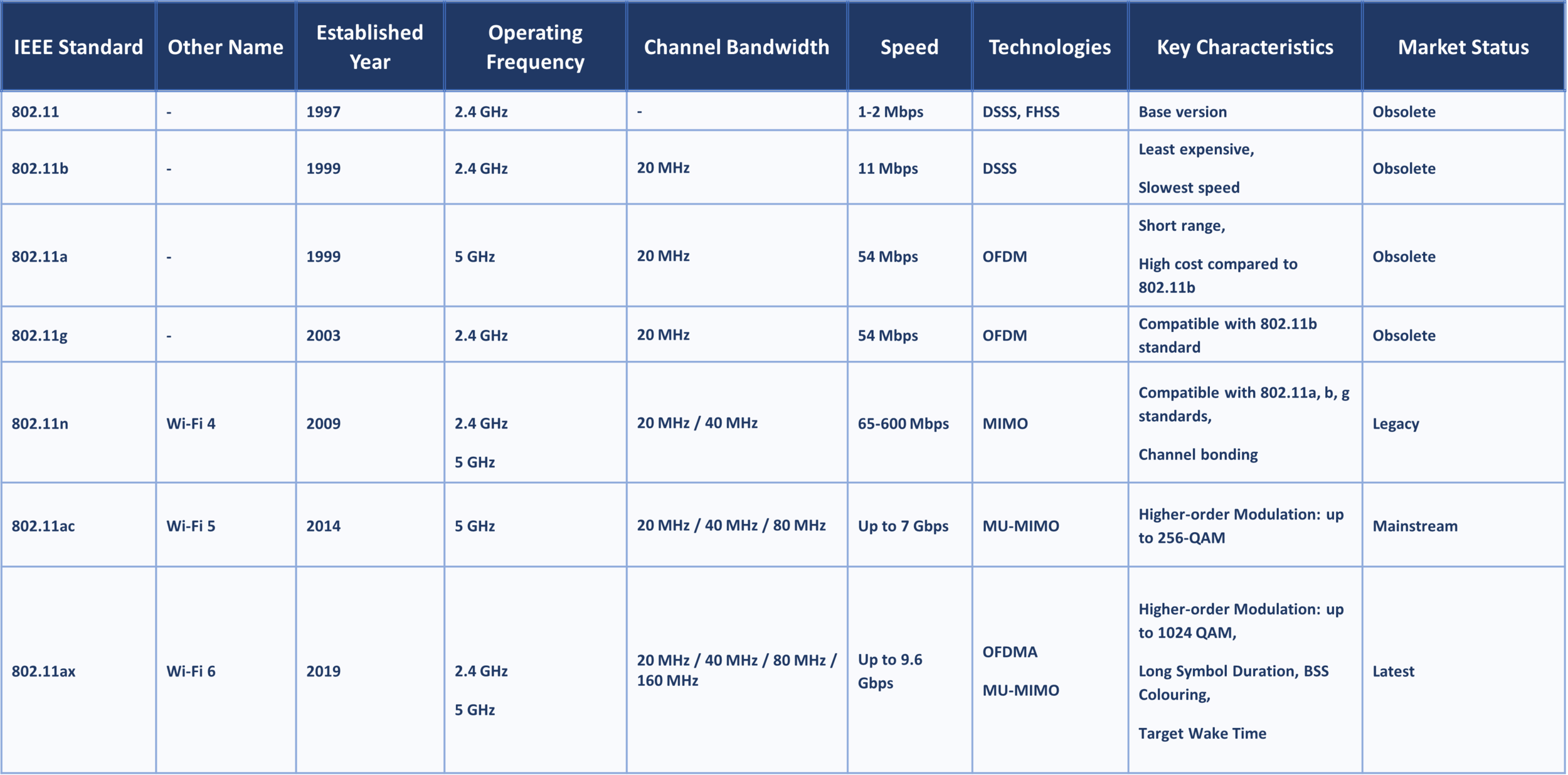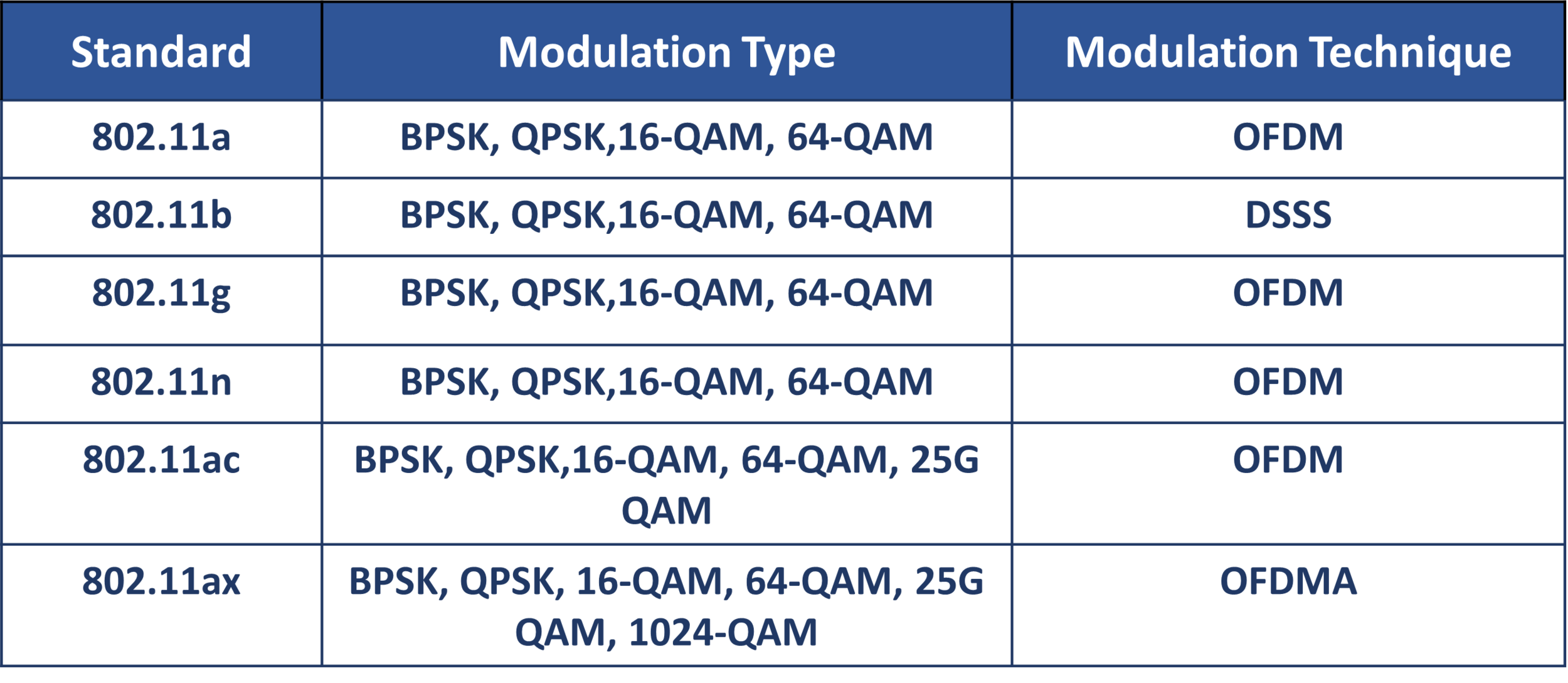Wi-Fi 6 - The Revolutionizer
The last few years have witnessed an explosive increase in the number of Wi-Fi devices. Today, nearly every mobile device chip with Wi-Fi has become an integral part of our everyday lives. This blog will be divided into three parts. This blog part will take you on a journey of what it means, the evolution of Wi-Fi technology, emphasizing the latest Wi-Fi generation (i.e., Wi-Fi 6), Wi-Fi modulation techniques and modulation types, and Wi-Fi architecture.
Introduction
Wi-Fi is an acronym for Wireless Fidelity. It is a wireless networking technology that allows devices such as computers, laptops, smartphones, wearables, other equipment such as printers and video cameras, etc., to connect with the Internet. Wi-Fi technology comes under wireless LAN technology, which means its coverage range is limited to short distances (e.g., home, office buildings, campuses, etc.). The Institute of Electrical and Electronics Engineers (IEEE) 802.11 standard defines the protocols that enable communications with Wi-Fi-enabled wireless devices, including wireless routers and wireless access points. Almost all the latest gadgets, smart devices support IEEE 802.11 standards. The standards operate on varying frequencies, deliver different bandwidths, and endorse other numbers of channels. The operating frequency for Wi-Fi is 2.4 GHz, 5 GHz, and 6GHz (6 GHz for Wi-Fi 6E). Wi-Fi signals are sent to devices via radio waves.
Evolution of Wi-Fi Technology
A quick overview of the different Wi-Fi generations is given in the table below:
Wi-Fi Generations
(Source : Lumenci)
Wi-Fi 6 Technology (IEEE 802.11ax standard)
The Wi-Fi Alliance, which oversees the implementation of the Wi-Fi standard, has certified the new wireless standard (IEEE 802.11ax), which is known as Wi-Fi 6. Wi-Fi 6 has been designed to fulfil the requirements of the current generation wireless networks mentioned below
High Connection Density: The number of devices requiring internet access is increasing day by day. To cope with this requirement of serving many devices, Wi-Fi 6 offers the feature of Basic Service Set (BSS) coloring.
Low Power Consumption: The development of battery-powered IoT devices requires operation at low power. To cope with this requirement, Wi-Fi 6 offers the feature of Target Wake Time (TWT).
High Data-rate : To improve the user experience in dense environments by maximizing average speeds for high connection density.
Key Features of Wi-Fi 6 Technology
The key features provided by Wi-Fi 6 technology are discussed below.
BSS(Basic Service Set) Coloring: Wi-Fi 6 offers a new feature called BSS coloring. Wi-Fi 6 implements a color code for each BSS. BSS coloring allows STAs to identify whether a device occupies the channel from its BSS (same color, intra-BSS packet) or another BSS (different color, inter-BSS container). Packages of one router are differentiated from another router by color, and other color packets are ignored. BSS coloring significantly reduces co-channel interference in high-density Wi-Fi environments. The color field is contained in the physical (PHY) header of all Wi-Fi 6 frames.
Without BSS coloring, STA in the same BSS share the same color, so they need to communicate with the AP. In comparison, BSS Coloring makes it possible for different BSSs to share the same channel, and BSS coloring enables additional channel reuse (see figure below).
TWT (Target Wake Time): In the past few years, the prevalence of IoT devices has grown significantly. Most IoT devices are battery-powered, so they need to manage their power (energy-efficiency). Because of energy-efficient requirements, Wi-Fi 6 offers a feature of TWT. IoT devices have greatly benefited from this feature, as the devices no longer need to be powered on and connected to Wi-Fi throughout the day. With TWT, STA negotiates when and how often they will wake up to transmit or receive data. The devices can "wake up" at their scheduled time, and the APs know when to listen for them. Since a Wi-Fi card does not have to be actively associating all day, TWT improves battery life.
Illustration of STAs operation: without TWT and with TWT scenarios
The other key modifications that are made in the Wi-Fi 6 over its Wi-Fi 5 (802.11ac) predecessor are listed below:
Technology Included: Orthogonal Frequency Division Multiple Access (OFDMA), Multi-User Multiple-Input-Multiple-Output (MU-MIMO), allowance of more spatial streams (i.e., 8 x 8 in both uplink and downlink), Beamforming
Modulation: Higher-order modulation (up to 1024-QAM)
OFDM Symbol Duration: Long (12.8 µs+0.8/1.6/3.2 µs in 802.11ax; 3.2 µs+0.4/0.8 µs in 802.11g/n/ac)
OFDM Subcarrier Spacing: Reduced (78.125 kHz in 802.11ax; 312.5 kHz in 802.11g/n/ac)
Wi-Fi 6 can achieve higher data rates due to the inclusion of above technologies such as OFDMA, MU-MIMO, allowance of more spatial streams and higher-order modulation.
Wi-Fi Modulation Techniques and Types
The modulation techniques and modulation types used by the different Wi-Fi generations are listed below:
Wi-Fi Architecture
The Wi-Fi architecture typically includes the following components.
Stations (STA): It includes the devices (e.g., mobile and laptop) which may connect to a Wi-Fi access point (AP).
AP: It typically refers to a Wi-Fi router, which provides Wi-Fi services to STA.
Basic Service Set (BSS): It defines the set of STAs associated with an AP. There are two modes of BSS discussed below (also illustrated with Figures below).
Infrastructure BSS: a BSS with an AP is classified as an Infrastructure BSS. In this mode, STAs communicate through AP.
Independent BSS: a BSS without an AP is classified as an independent BSS. In this mode, STAs communicate in an ad hoc manner.
Extended Service Set (ESS): a collection of BSSs is defined as ESS.
Distribution System (DS): DS connects APs in ESS.
Conclusion
Wi-Fi 6 delivers higher adequate speeds over its Wi-Fi 5 (802.11ac) predecessor. This is made possible by various technologies such as OFDMA, MU-MIMO with eight uplinks and eight downlinks, beamforming, 1024-QAM, and long OFDM symbol. Moreover, Wi-Fi 6 enables new features such as TWT and BSS Coloring to fulfill the current generation wireless networks' high connection density and low power consumption requirements. Stay tuned for Part 2 where we will cover the physical and MAC layer functionalities of different Wi-Fi generations, applications of Wi-Fi, and IP aspects of Wi-Fi 6.
*Disclaimer: This report is based on information that is publicly available and is considered to be reliable. However, Lumenci cannot be held responsible for the accuracy or reliability of this data.
*Disclaimer: This report is based on information that is publicly available and is considered to be reliable. However, Lumenci cannot be held responsible for the accuracy or reliability of this data.
Author
Satyam Kumar
Associate at Lumenci
Satyam Kumar Rao Associate at Lumenci. Satyam is an Associate at Lumenci with experience in Video codec, Networking and Telecommunication. He holds a B.Tech degree in Electrical Engineering from NIT Kurukshetra. He is interested researching new advancements in technology. He enjoys drawing, painting and listing to music in his spare time.










